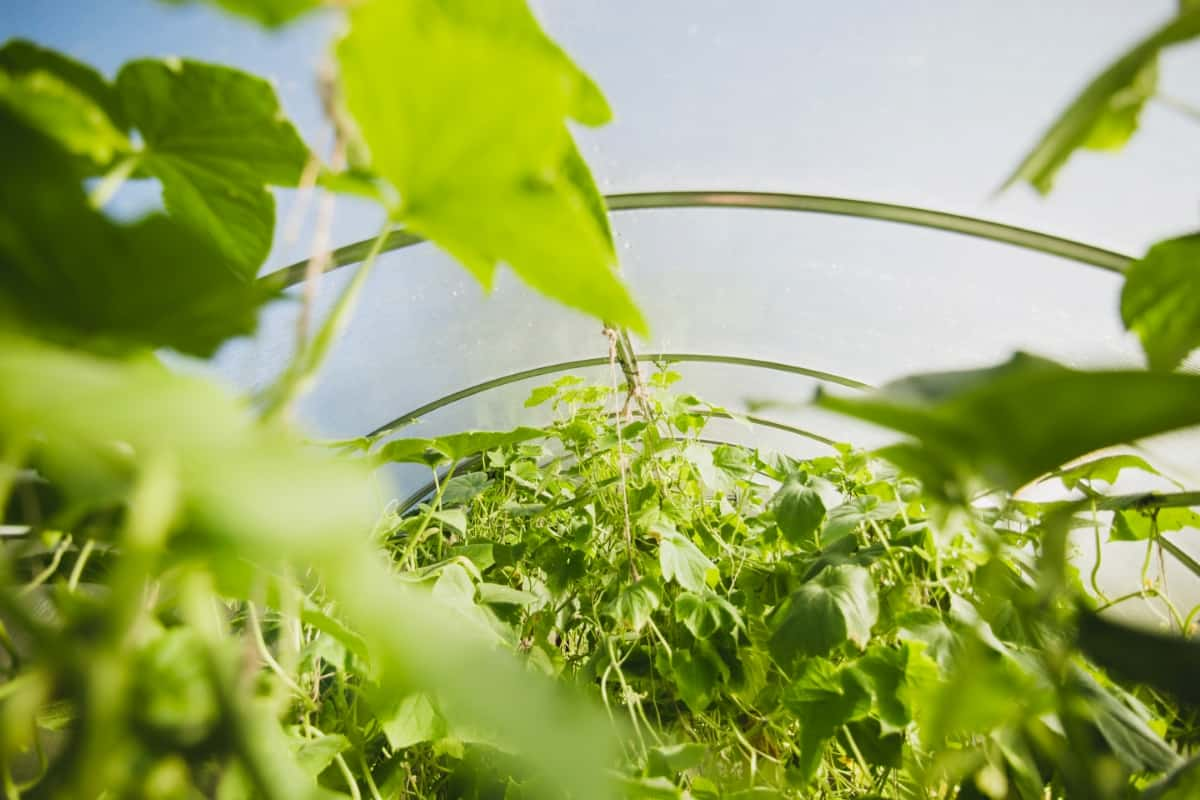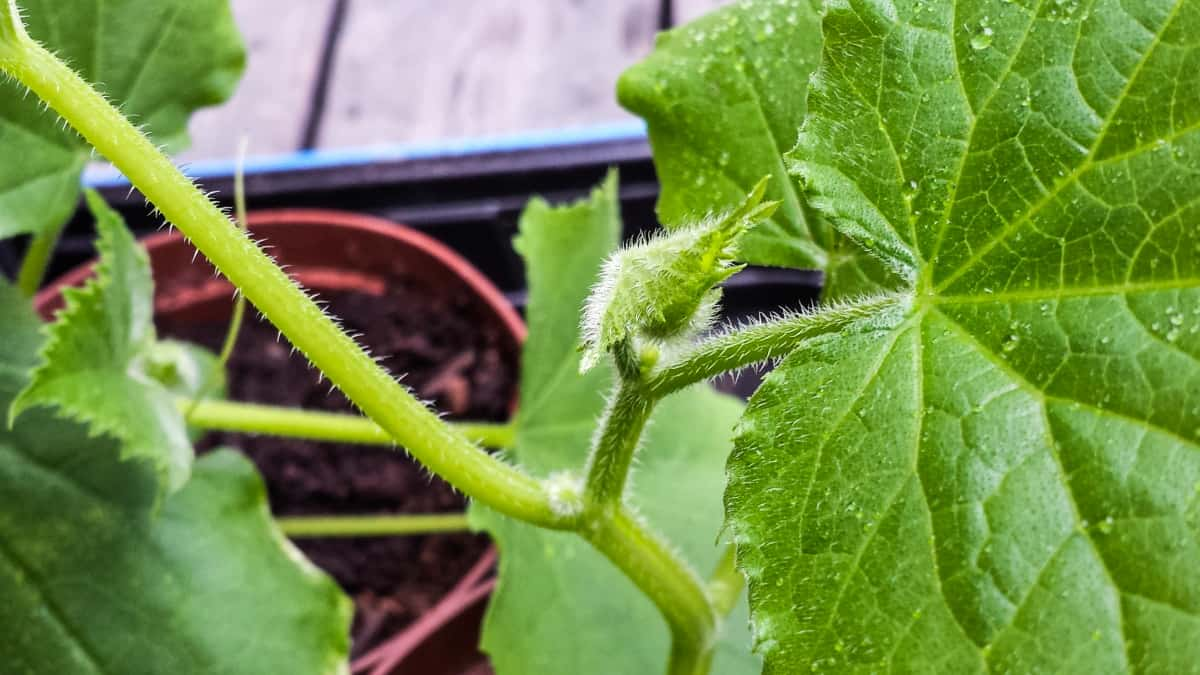It can be disheartening if your looks cucumber plant healthy but has no flowers. This article will brief you about the possible reasons behind this issue, provide useful tips, and suggest effective solutions to help your cucumber plant flourish and eventually bear fruit.

Cucumber Plant Looks Healthy But No Flowers
Understanding the Growth Cycle of Cucumber Plants
Like many other plants, cucumbers go through several growth stages, including sowing, germination, seedling, growth, flowering, fruiting, and harvesting. During germination, the cucumber seed sprouts and develops into a seedling. As it enters the vegetative growth stage, the plant starts focusing on leaf and stem development, establishing a strong foundation for future growth. Once the plant reaches maturity, it will transition into the flowering stage, producing the much-awaited flowers that eventually turn into cucumbers.
Factors Affecting Flowering in Cucumber Plants
Temperature: Cucumbers thrive in warm temperatures, typically between 21°C and 32°C. Cooler temperatures can delay or inhibit flowering.
Light: Cucumber plants require adequate sunlight to trigger the flowering process. Insufficient light, either due to shading or inadequate daylight hours, can hinder flower development.
Nutrients: Proper nutrition is vital for cucumber plants’ overall health and reproductive capabilities. A lack of essential nutrients, particularly phosphorus and potassium, can cause a delay in flowering.
Watering: Consistent and adequate watering is necessary for cucumber plants. Irregular watering, whether excessive or insufficient, can disrupt the plant’s hormonal balance, affecting flower production.
Causes of No Flowers on a Healthy Cucumber Plant
Immaturity: Cucumber plants need to reach a certain level of maturity before they start flowering. If your plant is still in its early stages of growth, it may simply need more time before it begins producing flowers.
Inadequate pollination: Cucumber plants rely on pollination for successful flower development. If there is a lack of pollinators or insufficient airflow, the flowers may not get adequately pollinated, resulting in a lack of fruit set.
Overfertilization: While nutrients are essential for plant growth, excessive fertilization, especially with nitrogen-rich fertilizers, can promote excessive vegetative growth instead flower production.
Stress: Environmental stressors like extreme temperatures, drought, or pest infestations can cause a cucumber plant to focus its energy on survival rather than flowering. Addressing and mitigating these stressors can help promote flower development.
In case you missed it: How to Identify and Treat Cucumber Pests: Organic, Natural Management Strategies

Pollination Issues in Cucumber Plants Without Flowers
Pollination plays a crucial role in cucumber plants’ flowering and fruiting process. Pollinators like bees, butterflies, and other insects transfer pollen from male to female flowers of cucumbers. This transfer of pollen initiates the development of fruit. Without proper pollination, cucumber plants may experience a lack of fruit set, resulting in healthy plants with no flowers.
To encourage pollination, it is beneficial to attract pollinators to your garden by planting flowers that attract them, such as marigolds or lavender. Application of Ethylene to increase female flowers in cucumber.
Environmental Factors Affecting Cucumber Flower Production
Insufficient Sunlight: Cucumber plants require at least 6-8 hours of direct sunlight to thrive and produce flowers. If your plant is not receiving enough sunlight, consider relocating it to a sunnier spot in your garden or using artificial grow lights to provide supplemental light.
Inconsistent Temperatures: Fluctuating temperatures can negatively impact the flowering of cucumber plants. In other words, it is the reason for no cucumber plant flowers. Aim for a consistent temperature range of 21-29°C during the day and around 15-21°C at night. Provide adequate protection, such as using row covers or a greenhouse, to shield the plants from extreme temperature fluctuations.
Excessive Heat: Extreme heat can also hinder flower formation in cucumber plants. To combat this, provide shade for your plants during the hottest part of the day or use mulch to keep the soil cool and retain moisture.
Nutrient Deficiencies and Lack of Cucumber Flowers
Nutrient deficiencies are one of the reasons for cucumber plants not flowering. Cucumbers require a well-balanced diet of essential nutrients to thrive and produce flowers. Insufficient levels of specific nutrients can hinder the plant’s ability to blossom. Some key nutrients crucial for flowering in cucumber plants include nitrogen, phosphorus, potassium, calcium, and magnesium.
In case you missed it: Cucumber Plant Flowers but No Fruit: Reasons, Tips, Remedies, and How to Fix

Conduct a soil test to determine the nutrient levels in your cucumber plant’s growing environment to address nutrient deficiencies. Based on the results, adjust the soil by incorporating organic matter or applying fertilizers specifically formulated for cucumber plants. Additionally, foliar feeding can be an effective technique to provide immediate nutrients to the plant.
Pruning Techniques to Encourage Flowering in Cucumber Plants
Pruning helps to control the plant’s growth, improve air circulation, and promote the development of lateral shoots, which ultimately leads to more flowers. When pruning cucumber plants, removing any damaged or diseased leaves is advisable, as they can hinder the plant’s overall health and vigor.
How to encourage flowering in cucumber plants? To encourage flowering, focus on pruning the main stem of the cucumber plant once it reaches a certain height. This will stimulate the growth of side shoots and encourage them to produce more flowers. Regularly pinch off the growing tips of the cucumber plant to redirect its energy toward flower production. Additionally, removing excessive foliage can enhance sunlight penetration, which is crucial for flower development.
Pest and Disease Management for Optimal Cucumber Plant Health and Flowering
Pests like aphids, cucumber beetles, and spider mites can infest the plant and hinder its blooming ability. Similarly, diseases that prevent cucumber plants from flowering are powdery mildew and bacterial wilt. To ensure optimal cucumber plant health and flowering, it is crucial to implement a robust pest and disease management strategy. This may involve regular monitoring, timely application of organic or chemical insecticides, and appropriate cultural practices such as maintaining proper spacing between plants.
Role of Genetics in Flowering Behavior of Cucumber Plants
Another important factor influencing the flowering behavior of cucumber plants is genetics. Different cucumber varieties have varying flowering habits; some may naturally have a delayed or reduced flowering tendency. If your cucumber plant belongs to such a variety, it may take longer to produce flowers than other varieties. In such cases, it is essential to be patient and provide the plant with the necessary care and conditions for optimal growth, eventually leading to flowering.
Troubleshooting Tips for Encouraging Flowering in Healthy Cucumber Plants
If your healthy cucumber plant is not producing blooms, here are the troubleshooting tips to encourage flowering. Firstly, ensure that the plant is receiving adequate sunlight. Cucumber plants thrive in full sun, so they receive at least 6-8 hours of direct sunlight each day. Additionally, ensure that the soil is well-drained and rich in organic matter.
Regularly water the plant, keeping the soil consistently moist but not soggy. Proper nutrition is also one of the key solutions for a cucumber plant with no blooms. Ensure that the plant receives a balanced fertilizer with adequate levels of phosphorus, promoting flower production.
In case you missed it: How to Protect Cucumbers from Aphids, Mites, and Beetles: Naturally and Organically

Avoid excessive nitrogen fertilization, as it can stimulate vegetative growth at the expense of flowering. Lastly, consider hand-pollinating the flowers to increase the fruit set. Cucumber plants require pollinators like bees for successful pollination. However, if pollinators are scarce in your area, manually transferring pollen from male to female flowers can help ensure fruit production.
Conclusion
While a healthy-looking cucumber plant without flowers can be concerning. You can encourage flower production and enjoy a bountiful cucumber harvest by ensuring proper pollination, maintaining optimal soil conditions, and employing appropriate pruning techniques.
- Feed Your Flock for Less: Top 10 Tips to Save on Chicken Feed
- Ultimate Guide to Ossabaw Island Hog: Breeding, Raising, Diet, and Care
- Hatching Answers: The Top 10 Reasons Your Chickens Aren’t Laying Eggs
- Eggs and Economics: Breaking Down the Cost of Raising Backyard Chickens
- Defend Your Greens: Proven Methods to Keep Iguanas Out of Your Garden
- Ultimate Guide to Cinnamon Queen Chicken: A Comprehensive Guide for Beginners
- Ultimate Guide to California Tan Chicken: Breeding, Raising, Diet, Egg-Production and Care
- Ultimate Guide to Marsh Daisy Chicken: Breeding, Raising, Diet, and Care
- 10 Types of Chicken Farming Businesses You Can Start for Profits